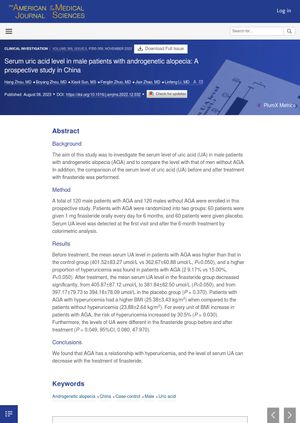TLDR Men with male pattern baldness have higher uric acid levels, which can decrease with finasteride treatment.
The prospective study involved 120 male patients with androgenetic alopecia (AGA) and 120 males without AGA. The study found that the mean serum uric acid (UA) level in patients with AGA was higher than that in the control group (401.52±83.27 umol/L vs 362.67±60.88 umol/L). A higher proportion of hyperuricemia was also found in patients with AGA (29.17% vs 15.00%). After treatment with finasteride, the mean serum UA level in the AGA group decreased significantly, from 405.87±87.12 umol/L to 381.84±82.50 umol/L. Patients with AGA with hyperuricemia had a higher BMI (25.38±3.43 kg/m2) compared to those without hyperuricemia (23.88±2.64 kg/m2). For every unit of BMI increase in patients with AGA, the risk of hyperuricemia increased by 30.5%. The study concluded that AGA has a relationship with hyperuricemia, and the level of serum UA can decrease with the treatment of finasteride.
17 citations
,
November 2021 in “Journal of Cosmetic Dermatology” Combination therapies for androgenetic alopecia work best but can have significant side effects and costs.
 4 citations
,
April 2020 in “Journal of Cosmetic Dermatology”
4 citations
,
April 2020 in “Journal of Cosmetic Dermatology” High uric acid levels link to male pattern baldness, especially in young men.
 15 citations
,
October 2016 in “Journal of The European Academy of Dermatology and Venereology”
15 citations
,
October 2016 in “Journal of The European Academy of Dermatology and Venereology” People with hair loss have worse cholesterol levels, possibly linking hair loss to heart problems.
 110 citations
,
August 2016 in “Drugs”
110 citations
,
August 2016 in “Drugs” Minoxidil is the only FDA-approved topical drug for treating male or female pattern hair loss, and other medications like finasteride and dutasteride can also increase hair growth.
16 citations
,
January 2016 in “Indian Journal of Dermatology, Venereology and Leprology” Metabolic syndrome is more common in people with early-onset androgenic alopecia.
 14 citations
,
March 2014 in “Journal of The European Academy of Dermatology and Venereology”
14 citations
,
March 2014 in “Journal of The European Academy of Dermatology and Venereology” Young adults with hair loss face higher risk of stiff arteries.
 38 citations
,
November 2013 in “Journal of The American Academy of Dermatology”
38 citations
,
November 2013 in “Journal of The American Academy of Dermatology” Higher BMI links to worse hair loss in Taiwanese men.
 November 2020 in “Elsevier eBooks”
November 2020 in “Elsevier eBooks” Antiandrogens and androgen inhibitors like spironolactone, finasteride, and dutasteride can treat hair loss and skin conditions, but they have risks and side effects, including potential harm to pregnant women and risks of cancer and heart issues. Herbal remedies also have antiandrogenic effects but lack safety validation.

New treatments for hair loss should target eight main causes and use specific plant compounds and peptides for better results.
December 2022 in “Biomedicine” Men with early onset hair loss are more likely to have high uric acid levels.
 4 citations
,
June 2019 in “International Journal of Dermatology and Venereology”
4 citations
,
June 2019 in “International Journal of Dermatology and Venereology” Some skin diseases may indicate a higher risk of metabolic syndrome and related health issues.
 4 citations
,
April 2020 in “Journal of Cosmetic Dermatology”
4 citations
,
April 2020 in “Journal of Cosmetic Dermatology” High uric acid levels link to male pattern baldness, especially in young men.









